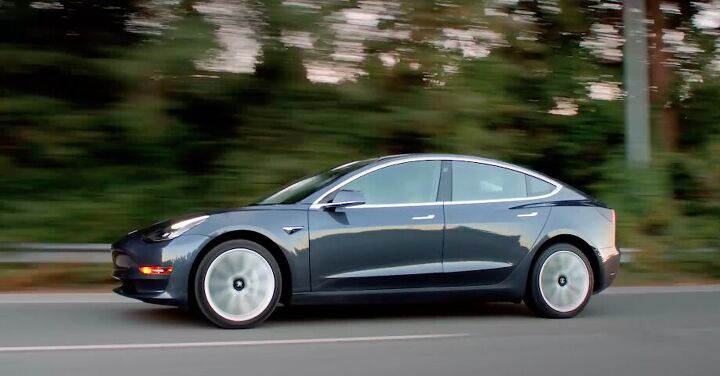Dual-motor Tesla Model 3 'Probably' Coming in July

It could happen, but then again, it may not. One thing’s for certain: buyers of the twin-motor Tesla Model 3 stand to wait less than those holding out for a base model.
In response to a Twitter user who asked when we can expect the all-wheel-drive variant of the massively hyped electric sedan (“My car has been sitting in the configuration for months waiting on it”), Tesla CEO Elon Musk replied with an approximate month. For this prediction to come true, Tesla must reach its second production target. It missed the first.
“We need to achieve 5k/week with Model 3 before adding complexity that would inhibit production ramp,” Musk tweeted. “So probably July.”
Actually, Tesla missed its first two Model 3 production targets — the first called for a production rate of 5,000 Model 3s per week by the end of 2017; the second, by end of the first quarter of 2018. Last week, the automaker reported that the week bridging March and April saw 2,020 Model 3s roll off the Fremont, California assembly line. The latest prediction was for 2,500/week by the end of Q1 2018.
For various reasons, including Musk’s claim of issues related to battery module assembly, the ramp-up of Model 3 production is taking longer than expected. Only pricier Long Range models have started production, with Musk previously telling reservation holders that the cheaper, $35,000 base models won’t see the assembly line until the end of 2018. His last prediction for dual-motor cars was mid-2018, so that goalpost hasn’t really changed.
Obviously, it makes more financial sense to get pricier variants into the driveways of buyers first, even if it means those who put $1,000 down on a base model when orders opened might have to wait close to two years to see production start. By then, the $7,500 federal tax credit will likely be halved.
Most reservations holders have no intention of buying the absolute cheapest base model once they’re invited to configure it online (options pile up fast), but that $35k sticker was awfully tempting. Given the level of devotion seen among the brand’s faithful, a mass exodus of reservation holders isn’t likely. Plus, rising production volumes, while still lower than expected, could help soothe budding frustrations. For some, anyway.
Cheat Sheet writer Eric Schaal isn’t among this group. Last week, he penned a column telling everyone exactly why he’s dumping his reservation.
[Image: Tesla]

More by Steph Willems
Latest Car Reviews
Read moreLatest Product Reviews
Read moreRecent Comments
- Honda1 Unions were needed back in the early days, not needed know. There are plenty of rules and regulations and government agencies that keep companies in line. It's just a money grad and nothing more. Fain is a punk!
- 1995 SC If the necessary number of employees vote to unionize then yes, they should be unionized. That's how it works.
- Sobhuza Trooper That Dave Thomas fella sounds like the kind of twit who is oh-so-quick to tell us how easy and fun the bus is for any and all of your personal transportation needs. The time to get to and from the bus stop is never a concern. The time waiting for the bus is never a concern. The time waiting for a connection (if there is one) is never a concern. The weather is never a concern. Whatever you might be carrying or intend to purchase is never a concern. Nope, Boo Cars! Yeah Buses! Buses rule!Needless to say, these twits don't actual take the damn bus.
- MaintenanceCosts Nobody here seems to acknowledge that there are multiple use cases for cars.Some people spend all their time driving all over the country and need every mile and minute of time savings. ICE cars are better for them right now.Some people only drive locally and fly when they travel. For them, there's probably a range number that works, and they don't really need more. For the uses for which we use our EV, that would be around 150 miles. The other thing about a low range requirement is it can make 120V charging viable. If you don't drive more than an average of about 40 miles/day, you can probably get enough electrons through a wall outlet. We spent over two years charging our Bolt only through 120V, while our house was getting rebuilt, and never had an issue.Those are extremes. There are all sorts of use cases in between, which probably represent the majority of drivers. For some users, what's needed is more range. But I think for most users, what's needed is better charging. Retrofit apartment garages like Tim's with 240V outlets at every spot. Install more L3 chargers in supermarket parking lots and alongside gas stations. Make chargers that work like Tesla Superchargers as ubiquitous as gas stations, and EV charging will not be an issue for most users.
- MaintenanceCosts I don't have an opinion on whether any one plant unionizing is the right answer, but the employees sure need to have the right to organize. Unions or the credible threat of unionization are the only thing, history has proven, that can keep employers honest. Without it, we've seen over and over, the employers have complete power over the workers and feel free to exploit the workers however they see fit. (And don't tell me "oh, the workers can just leave" - in an oligopolistic industry, working conditions quickly converge, and there's not another employer right around the corner.)































Comments
Join the conversation
Musk tweeted. “So probably July.” July 2019, 2020, or 2021?
Coming? Coming where? To a road? C'mon - really?!